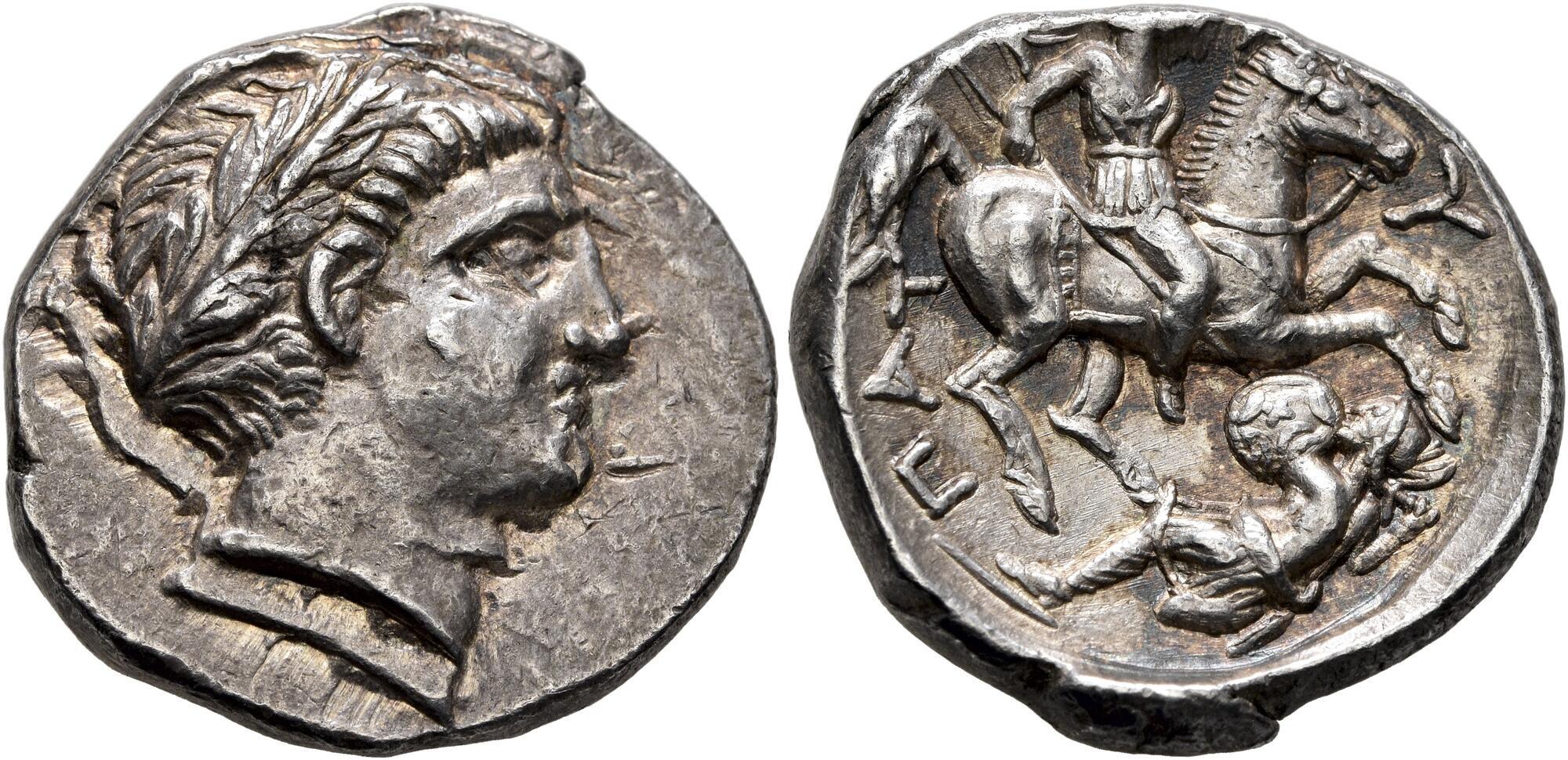Paeonia (uncertain mint) (Patraus), silver, tetradrachms (331-315 BCE)
From SILVER
335 BCE - 315 BCE Silver 8,641 kg
Description
| ObverseInscription or printing placed on the obverse.: | Laureate head of Apollo to right |
| ReverseInscription or printing placed on the reverse.: | ΠΑΤΡΑΟΥ (Greek).Paeonian horseman, wearing crested helmet and full armor, galloping right and spearing fallen enemy |
Mint and issuing power
| MintIdentifies the place of manufacture or issue of a numismatic object.: | Paeonia (uncertain mint) | Ancient regionAncient region.: | Paeonia | Modern countryModern country: | AuthorityIdentifies the issuing power. The authority can be "pretended" when the name or the portrait of X is on the coin but he/she was not the issuing power. It can also be "uncertain" when there is no mention of X on the coin but he/she was the issuing power according to the historical sources: | Paeonian kingdom, Patraus (king of Peonia, 340-315 BC) |
Chronology
| FromIdentifies the initial date in a range assigned in a numismatic context. | 335 BCE | toIdentifies the final date in a range assigned in a numismatic context.. | 315 BCE | PeriodTime period of the numismatic object.: Classical 480-323 BC |
Physical description
| MetalThe physical material (usually metal) from which an object is made.: | Silver |
Median weightMedian of the weights of numismatic objects (in grams). in grams | 12.70 | DenominationTerm indicating the value of a numismatic object. Examples: tetradrachm, chalkous, denarius.: | tetradrachm |
StandardStandard.: |
Image

Patraus_tetradrachms.jpg [1]
References
| Die study referencePublication of the study: | Sotheby's 19691Sotheby's 1969 | ||
| Coin series referenceReference to coin series study: | HGC 3.12HGC 3.1, n° 148 | ||
| Coin series web referenceCoin series web references: | |||
Obverse dies distribution
| FrequencyFrequency of specimen in distribution. ᵖ | Number of obversesNumber of obverse dies. ᵖ (o) | % (o) | Number of coinsNumber of coins. (n) | % (n) | Die nameName(s) of the die(s). |
| 1 | 14 | 41.18 | 14 | 3.4 | 77, 78, 81, 84, 93, 94, 165, 500, 501, 505, 506, 507, 509, 510 |
| 2 | 4 | 11.76 | 8 | 1.94 | 79-80, 82-83, 95-96, 166-167 |
| 3 | 1 | 2.94 | 3 | 0.73 | 169-171 |
| 4 | 4 | 11.76 | 16 | 3.88 | 73-76, 85-88, 89-92, 130-133 |
| 6 | 3 | 8.82 | 18 | 4.37 | 134-139, 159-164, 502-504+508+511 |
| 13 | 1 | 2.94 | 13 | 3.16 | 416-428 |
| 19 | 1 | 2.94 | 19 | 4.61 | 140-158 |
| 24 | 1 | 2.94 | 24 | 5.83 | 392-415 |
| 32 | 1 | 2.94 | 32 | 7.77 | 360-391 |
| 33 | 1 | 2.94 | 33 | 8.01 | 97-129 |
| 71 | 1 | 2.94 | 71 | 17.23 | 429-499 |
| 77 | 1 | 2.94 | 77 | 18.69 | 276-352 |
| 84 | 1 | 2.94 | 84 | 20.39 | 168+172-254 |
| Total | 34 of 34 | 99.98 | 412 of 412 | 100.01 |
Reverse dies distribution
no distribution is available
Quantification
| Number of obversesNumber of obverse dies. ᵖ (o) | 34 | Number of singletons (o1)The number of singleton coins. ᵖ | 14 |
| Number of reverse diesNumber of reverse dies. (r) | Number of coinsNumber of coins. (n) | 412 | |
| Coins per obverse dieNumber of coins per obverse die. (n/o) | 12.12 | Coins per reverse dieNumber of coins per reverse die. (n/r) | |
| Reverse per obverse ratioRatio of obverse dies divided by reverse dies. (r/o) | Percentage of singletons (o1)number of coins (n) divided by the number of singletons (o1) ᵖ | 41.18 % | |
| Original number of dies (O) (Carter 1983 formula)The estimation of the number of coins according to Carter 1983 ᵖ | 34.02 | Coins struck if 20,000 as average productivity per dieCoins made if the average productivity for obverses (according to Carter) is 20,000. ᵖ | 680,400 |
| Original number of dies (O) (Esty 2011 formula)The estimation of the number of coins according to the singleton formula in Esty 2011 ᵖ (O) | 37.06 | Survival rate if 20,000 as average productivity per dieSurvival rate if average productivity is 20,000. ᵖ | 0.00061 |
| Coverage (o = % of O) (Esty 1984 formula)Esty 1984 - coverage (% of O) ᵖ (o = % of O) | 96.6% | Die productivity if survival rate 1/2,000Average productivity if survival rate is 1/2,000. ᵖ | 24,221.05 |
| Weight of silver (in kg) if 20,000 coins per die (O = Carter formula)Carter 1983 * Median weight * 20000 (*10 if gold or electrum) ᵖ | 8,641 kg <br /> 8,641 kg | Die productivity if survival rate 1/5,000Average productivity if survival rate is 1/5,000. ᵖ | 60,552.62 |
Remarks
Most likely one single workstation Certainly military die-study from a single hoard